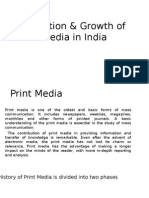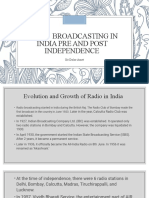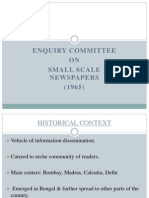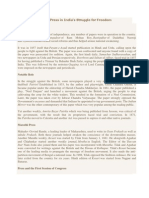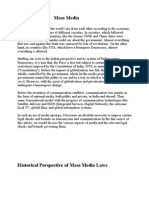James Silk Buckingham
James Silk Buckingham
Uploaded by
Harpreet SinghCopyright:
Available Formats
James Silk Buckingham
James Silk Buckingham
Uploaded by
Harpreet SinghOriginal Description:
Copyright
Available Formats
Share this document
Did you find this document useful?
Is this content inappropriate?
Copyright:
Available Formats
James Silk Buckingham
James Silk Buckingham
Uploaded by
Harpreet SinghCopyright:
Available Formats
Table of Contents
Table of Contents
Contents
James Silk Buckingham ________________________________________________________ 1 Contribution to Indian Journalism ________________________________________________ 2 Buckingham vs. Hickey ________________________________________________________ 6 Buckingham vs. Raja Ram Mohan Roy ____________________________________________ 8 References _________________________________________________________________ 9
Pg. 01
James Silk Buckingham
James Silk Buckingham
The newspapers came to India as an alien product, as one the benefits of British colonialism. The initial strength and power for launching of newspapers was directly fostered in England. James Augustus Hickey has the distinction of starting the press in India. Later, James Silk Buckingham got the title for being called as the Pioneer of true Indian Journalism. He infused a new light to Indian Journalism. He was the trailblazer among the Europeans who fought for liberal Press in India.
James Silk Buckingham
In 1821, his Travels in Palestine were published, followed by Travels Among the Arab Tribes in 1825. After years of wandering he settled in India, where he esta blished a periodical, the Calcutta Journal, in 1818. This venture at first proved highly successful, but in 1823 the papers outspoken criticisms of the East India Company led to the expulsion of Buckingham from India. Buckingham continued his journalistic ventures on his return to England. He started the Oriental Herald and Colonial Review (1824) and Athenaeum there. He was a prolific writer. He travelled in Europe, America and the East, and wrote many useful travel books, as well as many pamphlets on political and social subjects. At the time of his death in London, Buckingham was at work on his autobiography, two volumes of the intended four being completed and published.
Pg. 02
Contribution to Indian Journalism
Contribution to Indian Journalism
On September 22, 1818 the prospectus of a newspaper was published.
Buckingham was born in 1784 near Cornwell in England. Son of Christopher Buckingham, his was a chequered career-- as a jailor, printer, book-seller, mariner and editor. In 1813 he offered his services to the Pasha of Egypt to explore the Isthmus of the Suez to trace as far as possible the course of ancient canal. Thereafter he was given a commission by the Pasha to establish a trade between India and Egypt. But the venture did not succeed owing to unwillingness of the Bombay merchants. In June 1818 he commanding the Humayoon Shah when he was asked to sail to Madagascar coast for the purpose of giving convoy to some ships carrying slaves. Rather than embark on such an obnoxious quest, he surrendered his command. This gesture, widely applauded in Calcutta, did not escape the notice of the Company authorities and the other leaders of the society in Calcutta. It inspired the public to read the journal in which he had recorded some impressions of his travel in Palestine. His literary ability caught the imagination of John Palmer, head of the wellknown mercantile house of that name, palmer felt that the merchants of the city should
The Calcutta Journal appeared as biweekly with eight pages on Oct 2, 1818.
The motto of the newspaper was stated as, A forward retention of custom is as turbulent a thing as innovation and they that reverence too much old times are but a scorn to the new.
have their own paper to air their problems. He requested Buckingham to accept the editorship of the newspaper. Buckingham gave his consent. On September 22, 1818 Buckingham published a prospectus of a newspaper to be entitled the Calcutta Journal or Political or Literary Gazette. The prospectus announced: The state of the Press has been a subject of surprise, of disappointment, and of regret to all strangers on their first arrival in India: and the impression of its imperfections gradually loses its force after a long residence in the country, yet some of its ablest apologists and most zealous supporters acknowledged its reform to be desideratum. The Calcutta Journal appeared as bi-weekly with eight pages on Oct 2, 1818. The first issue came out with a quotation from Bacon in bold letters, which was declared to be the motto of the paper. It stated, A forward retention of custom is as turbulent a thing as innovation and they that reverence too much old times are but a scorn to the new. The paper was presented a wide selection of news and drew the attention of the
Pg. 03
Contribution to Indian Journalism
people and the authorities to such prevailing grievances as the insufficient state of the
As an editor, Buckingham considered it his Sacred right to admonish Governors of their duties, to warn them furiously of their faults and to tell disagreeable truths through his newspaper.
police and the allegations that certain persons in European dress were making the streets of Calcutta unsafe at night. The correspondence columns were thrown open to any who had grievances to air. As an editor, Buckingham said, he considered it his Sacred right to admonish Governors of their duties, to warn them furiously of their faults and to tell disagreeable truths. He courageously faced all odds, followed the motto scrupulously and performed his duties fearlessly. The paper was the success from its very first issue. The paper, well conducted, independent and cleaver, become a talk of the town in no time. Buckingham was a Whig and most of his reprints from the British papers were in condemnation of the Tories. He also gave a proof of his literary bent of mind by introducing Byrons Childe Harold and Don Juan and Scotts Ivanhoe to Calcutta readers1. As a sailor he was interested is development of new means of communication. He drew attention in his columns to the North-west passage, Red sea
On May1, 1819 the Calcutta Journal was converted in to the First Daily of Calcutta.
route, steam navigation, and the possibility of a voyage by air from Bombay to London. A champion of free trade, Buckingham campaigned for the abolition of East India Companys monopoly. In his view the whole continent of Asia should be opened to the unrestricted competition of whoever was willing to risk his health and fortune. The government and the papers which he criticized in his prospectus now joined hands to crush him. Undaunted, Buckingham soon converted his bi-weekly into the first daily of Calcutta on May1, 1819 under all the disadvantages of a combined opposition.
Modern History of Indian Press, p 42 (Sunit Ghosh)
Pg. 04
Contribution to Indian Journalism
Quite expectedly, the existing newspapers in Calcutta received this newspaper with violent opposition. Rev Samuel James Bryce, who owned the Asiatic Mirror, openly
cast doubts on the moral standard of the new editor. His allegations were based on the fact that Buckingham had demonstrated the steps of a quadrille on Sundayapparently a heinous offence against Bryces ideas of Sabbath. But the counter statements given by Buckingham resulted the death of Asiatic Mirror. The financial success of the journal enabled it to have its own building constructed, a new improved Columbian Press imported from England together with English, Greek, Hebrew and Arabic fonts. The value of the enterprise in 1822 was estimated at 40,000 pounds. According to Margarita Barns, Buckinghams yearly income was about eight thousand pounds, he may be called on of the leading pioneers of modern journalism in India.2 Buckingham late emphasized on news of local conditions rather than talking about fashion, social elites or criticism of popular people. He was fearless in writing against certain Indian customs like Sati system. Parda and child marriages. He started giving prominence to news and views published in Bengali and Persian and started printing the summary into Calcutta Chronicle. He advocated the policy of freedom press &
The Indian Press, p 96 (Barns)
Pg. 05
Contribution to Indian Journalism
expression. He was of an opinion that free press is required to keep a check on the working of the government. In 1819 he again targeted corrupt system of East India Company by making adverse comments on the appointment of Hugh Elliot as the Governor of Madras. An infuriated Elliot asked the Calcutta authorities to punish the editor. The Government at Fort William sent a warning to the editor with which was enclosed a copy of Press Rules of 1818. But Buckingham carried on his tirade and spared none in his attacks. Not even the Chief Justice, the Governor of Madras or the Lord Bishop of Calcutta. Libel suits were filed against him. He was also threatened and physically assaulted. Despite heavy odds Buckingham had so long held aloft his ideal of press freedom. But his fortune suffered a jolt after Hastings regime came to an end. John Adams became the officiating Governor- General on January 13, 1823. He was also against the Buckingham and his newspaper. He revoked Buckinghams license to stay in India. And, finally, he was deported back to England in 1823. In England he filed a case against East India Company and was awarded 500 pounds as a compensation every year in 1834.
In 1823, Buckinghams license to stay in India was revoked and he was deported back to England.
Pg. 06
Buckingham vs. Hickey
Buckingham vs. Hickey
James Silk Buckingham versus James Augustus Hickey
James Augustus Hickey
James Augustus Hickey was an Irishman who is considered as the birth giver of Indian press. He is the person who started a newspaper which was called as Hickeys Gazette or Bengal Gazette; even it was aliased as Calcutta General Advertiser which came into being on January 29th 1780. It declared itself as weekly Political and commercial paper open to all parties but influence by none . It is very important to observe the statement which implicates that the newspaper was not influenced by the Government or other party, but to the interest of people, which although proved to be a tool used by James Augustus Hickeys personal contention with the British rule or its representative- East India Company.
The content was mainly for criticizing the East India Company. But to make it more catchy and readable, Hickey added other things four page Gazette, like a Gossip column, a poets corner, news related the European scandals and most importantly the advertisement. The thing to be noted here is that the content was used to more emphasis on criticizing the men in power like Warren Hastings and even people related to the rulers like Lady Hasting. The content of Hickeys Gazette was used more for acting as a tool of criticism and not for the benefit of the general masses and public. A severe criticism can be done to Hickeys Gazette as it lacked the ethics of Journalism
Pg. 07
Buckingham vs. Hickey
and was more slang-using nicknames of people, and also wasnt a benefactor t o the common public.
If we compare and set a contrast between Hickeys contribution to the contribution of James Silk Buckingham; there is no doubt that Hickey provided and initiated a platform for Indian press, but we cant deny and defy the fact that Buckinghams contribution is more legendry and praise worthy. Buckingham was an Anglo-Indian who is titled as the Father of true Indian Journalism. He in true sense can be termed as pioneer of ethical Journalism of India. It is said that in the early years of 19 th century, Calcutta saw the emergence of a first real and outstanding journalist. Jawaharlal Nehru has described him as the earliest champions of the freedom press in India and one who is still remembered in this country. Although, he came to India as an editor of the Calcutta Chronicle, which was started by the Calcutta merchants to safeguard their vested interested, but Buckingham laid more emphasis and meant his content for uplifting the issues of common public, news of local conditions and purified his content from making criticism, fashion, advertisement, gossip and Anglo Social Scandals. He was more concerned about the social reforms and that is the reason, he was more liked by the public. He was also coordinate by Raja Ram Mohan Roy, as he became a pioneer of not only the freedom of speech and expression but a social reformer as well. The reason can be drawn as for he was more accustomed to the rituals, cultures, beliefs and values of Indian masses in particular and world in general. He was a prolific writer and was more successful in influencing the hearts of suppressed people of British India. In conclusion, it can be said that James Augustus Hickey is the pioneer of Indian press; but the title of Pioneer of True Indian Journalism, must be given to James Silk Buckingham.
Pg. 08
Buckingham vs. Raja Ram Mohan Roy
Buckingham vs. Raja Ram Mohan Roy
James Silk Buckingham versus Raja Ram Mohan Roy
In late 18th century two eminent personalities appeared in the field of journalism in Calcutta. They were James Silk Buckingham, an Englishman and Raja Ram Mohan Roy. Both fought energetically against any bureaucratic encroachment on freedom of press and suffered for it but left the impress of their vision and character on contemporary journalism. Both played a significant role for the freedom of the press. Both attracted the staunchest supporters from among their countrymen and at the same time provoked bitterest antagonism. Ties of friendship and mutual admiration brought them closer and they waged relentless fights for the right of the press simultaneously in England and in India.
Raja Ram Mohan Roy
Raja Ram Mohan Roy was on Indian scene from 1772-1823. He was born in a Brahmin family. Raja Ram Mohan Roy was also credited for laying the foundation of Indian Journalism. He was perhaps the first Indian journalist. He remembered for bringing in social change in India. He brought a renaissance in Hindu society. The prime focus of Buckingham was to promote open trade across the Middle East whereas Roy wanted to eradicate the social evils from Indian society. Buckingham started Calcutta Journal with a motive to promote trade and was fully devoted to mercantile class. Roy started Sambad Kamumdi (moon of intelligence) and Mirut-ul-ukbar to bring a social change in the Indian society. Later on, they both fought for the freedom of the Press. Buckingham also published some articles against Hindu costumes like Parda system, Sati System and Child Marriages.
Pg. 09
References
References
Textual Books
1. Modern History of Journalism (Sunit Ghosh) 2. Handbook of Journalism & Mass Communication (Vir Bala Aggarwal & VS Gupta) 3. History of Press, Press Laws and Communications (B.N. Ahuja)
Electronic Books & Websites
1. History of Media and Media Legislation in India 2. Blogger 3. Media in India (N Ananth Padmanabha)
Photographs
1. Google images
You might also like
- James Silk Buckingham As The Father of True Indian JournalismDocument7 pagesJames Silk Buckingham As The Father of True Indian JournalismDaliya ChakrobortyNo ratings yet
- Development of Indian PressDocument6 pagesDevelopment of Indian PressKarthikPrakashNo ratings yet
- History of Indian JournalismDocument16 pagesHistory of Indian JournalismVysakh60% (10)
- The Nitesh Sengupta Committee Report On Prasar BharatiDocument31 pagesThe Nitesh Sengupta Committee Report On Prasar BharatiVipul Partap0% (1)
- Chinese XXX Tube China XXX Tubetdoty PDFDocument2 pagesChinese XXX Tube China XXX Tubetdoty PDFDixonFletcher76No ratings yet
- Emmanuel Macron in His Own Words (English) - TranscriptDocument16 pagesEmmanuel Macron in His Own Words (English) - Transcriptpeppermint1151No ratings yet
- HickeyDocument1 pageHickeyHrittika DeyNo ratings yet
- Historical Growth of Indian PressDocument10 pagesHistorical Growth of Indian PressJanardhan Juvvigunta JJNo ratings yet
- Press Council of IndiaDocument10 pagesPress Council of Indiasaurabh yadavNo ratings yet
- Press CommissionsDocument3 pagesPress CommissionsDeepu JoseNo ratings yet
- History of Radio in IndiaDocument8 pagesHistory of Radio in IndiaSarin Sayal100% (1)
- History of Radio Broadcasting in IndiaDocument3 pagesHistory of Radio Broadcasting in IndiaILLIYANANo ratings yet
- Mass Media During EmergencyDocument12 pagesMass Media During EmergencymanojNo ratings yet
- Commercialisation of The Indian Television IndustryDocument7 pagesCommercialisation of The Indian Television IndustryAbhinav Chhabra100% (1)
- First Press Commission-23 Sep, 1952Document5 pagesFirst Press Commission-23 Sep, 1952saurabh yadavNo ratings yet
- Radio & Vidyalankar CommittteeDocument11 pagesRadio & Vidyalankar Committteesudeshna86No ratings yet
- First Press CommissionDocument4 pagesFirst Press CommissionVanalika Kapoor70% (10)
- Media Ownership in IndiaDocument11 pagesMedia Ownership in IndiaBarathNatarajNo ratings yet
- Press Commission and Press Council of India - Journalism and CommunicationDocument6 pagesPress Commission and Press Council of India - Journalism and CommunicationFranklin.RajaNo ratings yet
- Commitee 1Document11 pagesCommitee 1Vedansha SinghalNo ratings yet
- History of TV in IndiaDocument8 pagesHistory of TV in Indiarenur6890No ratings yet
- Types of Newspaper Ownership in IndiaDocument3 pagesTypes of Newspaper Ownership in IndiaSun MahajanNo ratings yet
- Media ConglomerationDocument2 pagesMedia ConglomerationDEEPAK GROVER80% (5)
- History of Mass Media in NepalDocument8 pagesHistory of Mass Media in NepalYumesLamaGurung0% (1)
- Evolution & Growth of Media in IndiaDocument15 pagesEvolution & Growth of Media in IndiaSaumya Saxena50% (2)
- Radio Broadcasting in India Pre and Post IndependenceDocument7 pagesRadio Broadcasting in India Pre and Post IndependenceAkshat BhatlaNo ratings yet
- Enquiry Committee On Small Scale Newspapers, 1965 - Shilpa Narani/Suvojit Bandopadhyaya - Semester 3 (Batch 2010 - 2012)Document35 pagesEnquiry Committee On Small Scale Newspapers, 1965 - Shilpa Narani/Suvojit Bandopadhyaya - Semester 3 (Batch 2010 - 2012)altlawforumNo ratings yet
- Kheda and Jhabua Site ProjectDocument2 pagesKheda and Jhabua Site ProjectSHUBHANGI CHOWDHURY100% (2)
- Media Ownership in IndiaDocument12 pagesMedia Ownership in IndiapriyankaNo ratings yet
- Advertising Agencies Association of IndiaDocument3 pagesAdvertising Agencies Association of IndiaChristina JohnsonNo ratings yet
- Freedom of Press in IndiaDocument35 pagesFreedom of Press in IndiaSiddharth Gandhi90% (10)
- Varghese Committee 2Document72 pagesVarghese Committee 2Kumar ManojNo ratings yet
- Brief History of Radio Broadcasting in IndiaDocument2 pagesBrief History of Radio Broadcasting in IndiaArnab Mondal100% (1)
- History of Print MediaDocument5 pagesHistory of Print MediaDigi StrengthNo ratings yet
- Press Commission and Their Recommendations-1Document15 pagesPress Commission and Their Recommendations-1Sanjay shukla100% (4)
- Present Relevance of Television Audience Measurement Ratings in News ChannelsDocument11 pagesPresent Relevance of Television Audience Measurement Ratings in News ChannelsShruti PedamkarNo ratings yet
- HISTORY OF TELEVISION in IndiaDocument51 pagesHISTORY OF TELEVISION in IndiaRebekah JulianneNo ratings yet
- Role of Press in IndiaDocument13 pagesRole of Press in IndiaAkash Shrivastava100% (4)
- Historical Perspective of Mass Media LawsDocument10 pagesHistorical Perspective of Mass Media LawsDEEPAK GROVERNo ratings yet
- Press Commission in IndiaDocument3 pagesPress Commission in Indiaprasun_bhaNo ratings yet
- Embedded Journalism: Global Media Scenario Tejaswini Semester 3, Section CDocument8 pagesEmbedded Journalism: Global Media Scenario Tejaswini Semester 3, Section CTejaswini Mishra0% (1)
- Magazine Journalism: The Magazine Industry - What Is A Magazine?Document26 pagesMagazine Journalism: The Magazine Industry - What Is A Magazine?ALEXANDERNo ratings yet
- Unit 3 - Major Media Laws in IndiaDocument7 pagesUnit 3 - Major Media Laws in IndiaAMAL MANOHARANNo ratings yet
- History of The Hindu NewspaperDocument4 pagesHistory of The Hindu NewspaperMahima SinghNo ratings yet
- MacBride CommissionDocument1 pageMacBride CommissionDEEPAK GROVER83% (12)
- The Growth and Development of Radio in IndiaDocument8 pagesThe Growth and Development of Radio in IndiaSubhasis Raha100% (1)
- Print Journalism NotesDocument90 pagesPrint Journalism NotesPari NirwalNo ratings yet
- Broadcasting & Production RightsDocument12 pagesBroadcasting & Production RightsUtkarsh KhandelwalNo ratings yet
- Individual Ownership Pattern - in This Kind ofDocument13 pagesIndividual Ownership Pattern - in This Kind ofMmanjunath MunishamaiahNo ratings yet
- Growth and Development of Online Journalism in IndiaDocument8 pagesGrowth and Development of Online Journalism in IndiaGourav Vishwakarma100% (2)
- History of India TodayDocument13 pagesHistory of India TodayfarromelvynNo ratings yet
- Broadcasting Codes of AIR/DDDocument16 pagesBroadcasting Codes of AIR/DDKavita ko100% (3)
- BRIEF HISTORY OF INDIAN MEDIA - by KunalDocument7 pagesBRIEF HISTORY OF INDIAN MEDIA - by KunalSima KhatunNo ratings yet
- Role of Press in IndiaDocument13 pagesRole of Press in IndiaVijay ParmarNo ratings yet
- Print JournalismDocument30 pagesPrint JournalismLeonardoNo ratings yet
- Critique of International News AgenciesDocument2 pagesCritique of International News AgenciesDEEPAK GROVER100% (1)
- Elements of A News BulletinDocument4 pagesElements of A News BulletinDhruv S100% (1)
- Media Laws - An IntroductionDocument25 pagesMedia Laws - An IntroductionVipul Partap100% (1)
- Ethics of Media ManagementDocument11 pagesEthics of Media Managementapi-390462542100% (2)
- The Early History of Press Freedom in Bengal - The Daily StarDocument6 pagesThe Early History of Press Freedom in Bengal - The Daily Staralazad.tanveerNo ratings yet
- A History of Press Legislation in IndiaDocument67 pagesA History of Press Legislation in IndiaNaruto UchihaNo ratings yet
- script (1)Document15 pagesscript (1)David BrainardNo ratings yet
- Research ParadigmDocument11 pagesResearch ParadigmHarpreet Singh100% (1)
- List of Candidates 24.01.2017Document44 pagesList of Candidates 24.01.2017Harpreet SinghNo ratings yet
- Maulana Azad Fellowship Guidelines by UGCDocument16 pagesMaulana Azad Fellowship Guidelines by UGCHarpreet SinghNo ratings yet
- Advantages of Centralised Structure For OrganisationsDocument3 pagesAdvantages of Centralised Structure For OrganisationsHarpreet SinghNo ratings yet
- Development CommunicationDocument17 pagesDevelopment CommunicationHarpreet Singh100% (4)
- Management & Its FeaturesDocument4 pagesManagement & Its FeaturesHarpreet SinghNo ratings yet
- Heads of Argumen 30818 Draft 3 Final PhaseDocument39 pagesHeads of Argumen 30818 Draft 3 Final PhasePeter WatsonNo ratings yet
- Clorox Case StudyDocument2 pagesClorox Case StudyRohan GuptaNo ratings yet
- IIANL Strategy Related AuditingDocument31 pagesIIANL Strategy Related AuditingAlfonso ChenNo ratings yet
- Bread and Pastry NC II CGDocument24 pagesBread and Pastry NC II CGMia CristialenNo ratings yet
- Unit 2: Talents: Talents or Super Human Powers?Document5 pagesUnit 2: Talents: Talents or Super Human Powers?ivii (Ivii)No ratings yet
- Grade 8-Q1-P.e-Learners Progress ReportDocument4 pagesGrade 8-Q1-P.e-Learners Progress ReportERNALYN GEM GEM G. RAFER-PANDINo ratings yet
- Cameron Magida ResumeDocument1 pageCameron Magida Resumeapi-292468471No ratings yet
- Indian Navy Civilian Entrance Test INCET-TMM-01/2019Document9 pagesIndian Navy Civilian Entrance Test INCET-TMM-01/2019PAWAN YADAVNo ratings yet
- Implementación Del Trabajo Estandarizado en La Industria de La ConstrucciónDocument11 pagesImplementación Del Trabajo Estandarizado en La Industria de La ConstrucciónJorge BlancoNo ratings yet
- National Safety and Quality Health Service Standards Second EditionDocument86 pagesNational Safety and Quality Health Service Standards Second EditionMRS FKM UH100% (1)
- GJT Rebuilders V Ricardo AmbosDocument1 pageGJT Rebuilders V Ricardo AmbosPaul Arman MurilloNo ratings yet
- Feist Publications, Inc. v. Rural Telephone Service Co., 499 US 340 - Supreme Court 1991 - Google Scholar PDFDocument7 pagesFeist Publications, Inc. v. Rural Telephone Service Co., 499 US 340 - Supreme Court 1991 - Google Scholar PDFJazztine ArtizuelaNo ratings yet
- Clinic Managment Software For DoctorsDocument37 pagesClinic Managment Software For Doctorsdocterz seoNo ratings yet
- Values Ed - PEAC Streamlining The K 12 CurriculumDocument108 pagesValues Ed - PEAC Streamlining The K 12 CurriculumBin Abubakar100% (1)
- SS Venture Internation V Ss Ventures Labor Union - DigestDocument3 pagesSS Venture Internation V Ss Ventures Labor Union - DigestNylaNo ratings yet
- JenniferNolasco - P3 U7 DISTRIBUTION and DELIVERY Winter 2021Document11 pagesJenniferNolasco - P3 U7 DISTRIBUTION and DELIVERY Winter 2021Jenny NolascoNo ratings yet
- B B M-New-syllabus PDFDocument89 pagesB B M-New-syllabus PDFRajiv MohanNo ratings yet
- Living Labs Roadmap 2007-2010Document61 pagesLiving Labs Roadmap 2007-2010European Network of Living Labs100% (2)
- Supply Chain Practices in The Context of An Emerging EconomyDocument92 pagesSupply Chain Practices in The Context of An Emerging EconomyJohan Manuel RiveraNo ratings yet
- Trung Nguyen Supply Chain in Vietnam Amazone: 1. SCM Context & ObjectivesDocument1 pageTrung Nguyen Supply Chain in Vietnam Amazone: 1. SCM Context & ObjectivesBình NguyễnNo ratings yet
- Customer Satisfaction and Customer DelightDocument18 pagesCustomer Satisfaction and Customer DelightWedi TassewNo ratings yet
- Raymond ModelDocument7 pagesRaymond Modelpooja jaiswalNo ratings yet
- Fencing & Landscaping News - February 2010Document84 pagesFencing & Landscaping News - February 2010FencingNewsNo ratings yet
- Success Story of Elon MuskDocument2 pagesSuccess Story of Elon MuskBhavya ShrivastavaNo ratings yet
- HRM Unit 1 Chapter 1Document28 pagesHRM Unit 1 Chapter 1MohitNo ratings yet
- Regoniel, Patrick: Cristina PrundDocument4 pagesRegoniel, Patrick: Cristina PrundPearl CabigasNo ratings yet
- Quiz ReviewerDocument2 pagesQuiz ReviewerRose Dela CruzNo ratings yet
- Chutzpah 1Document41 pagesChutzpah 1Uriah100% (1)
























